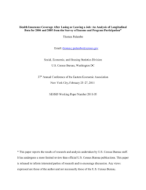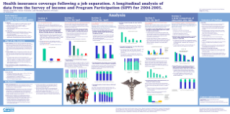Health Insurance Coverage After Losing or Leaving a Job: An Analysis of Longitudinal Data for 2004 and 2005 from the Survey of Income and Program Participation
Health Insurance Coverage After Losing or Leaving a Job: An Analysis of Longitudinal Data for 2004 and 2005 from the Survey of Income and Program Participation
This paper reports the results of research and analysis undertaken by U.S. Census Bureau staff. It has undergone a more limited review than official U.S. Census Bureau publications. This paper is released to inform interested parties of research and to encourage discussion. Any views expressed are those of the author and not necessarily those of the U.S. Census Bureau.
Introduction
In 2009, nearly 64 percent of the people in the United States were covered by a private health insurance plan; in 2007, prior to the recession that began in 2008, the comparable figure was 67 percent (DeNavas-Walt, 2010 and 2009). Reliance on private coverage means that a job separation (losing or leaving a job) can put an individual, and his or her dependents, at risk of losing health insurance, or of experiencing an adverse change in its cost or conditions. Fairlie and London (2008) found that job loss was one of the factors most highly associated with the loss of health insurance coverage.
This paper uses longitudinal data for 2004 and 2005 from the Survey of Income and Program Participation (SIPP) to observe how health insurance coverage changes in the aftermath of a job separation followed by a period of unemployment. It focuses primarily on workers in the prime working-ages of 20 to 64 years who were covered by private health insurance prior to a job separation.
Private health insurance coverage is either provided through an employer or a union, or purchased by an individual from a private company (direct-purchase). A job separation may affect private coverage by canceling or altering the conditions of employment, or by reducing the income needed to purchase a health insurance plan. Legal provisions or contractual obligations may alter the potential effects of a job separation on health insurance coverage, depending upon the type of coverage an individual has at the time of the separation.
The connection between jobs and health insurance coverage may negatively impact the well-being of individuals and families directly involved in a job separation. Loss of health insurance coverage, for instance, may place individuals at risk of significant financial loss, and lead them to avoid or delay seeking medical care (Cummings et al, 2009; Smith et al, 2006). Beyond direct effects, the risks of connecting health insurance to employment likely reverberate among workers and the labor market in general. The fear of losing health insurance coverage, for example, may lock workers into less productive jobs (Sanz-De-Galdeano, 2006).
Safety nets have been erected at the federal and state government levels to respond to the negative aspects of the job-health insurance relationship. The federal Consolidated Omnibus Budget Reconciliation Act (COBRA) program, the Health Insurance Portability and Accountability Act of 1996 (HIPAA), and state and federal Medicaid programs, offer some protections against the loss of health insurance coverage due to job separations (U.S. Department of Labor, 2002; 2010(a); 2010(b)). Jobless workers, however, may not be able to afford coverage under COBRA or HIPAA, or meet the eligibility requirements of these programs or those of Medicaid . Even when a safety net is in place for an individual, falling into it or dangling above it may have unwelcome or undesirable consequences.
The decision to frame the analysis of this paper within calendar years 2004 to 2005 was based on the availability of data. The economy was expanding in those years, with the labor market seeing continued improvement. Once comparable data from the SIPP are available for the recession and the sluggish economy that followed December 2007, we intend to study how the findings in this paper differ from those for this later period.
Others in Series
Working Paper
Working Paper
Working Paper





